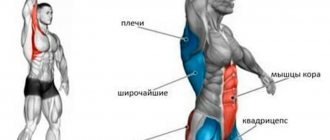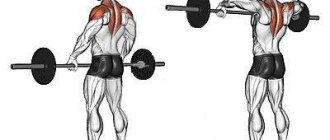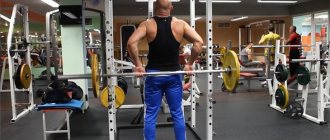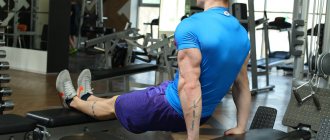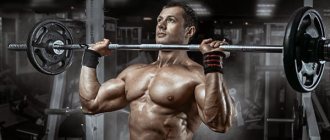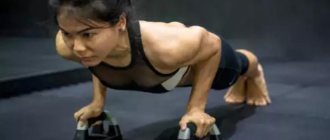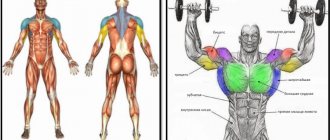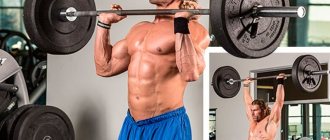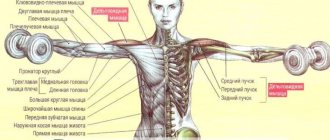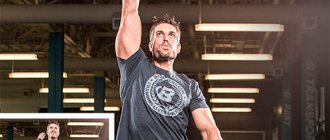( 2 ratings, average: 5.00 out of 5)
Home » Exercises
One of the most effective strength training exercises is lifting a barbell in front of you while standing. With such strength gymnastics, the muscles of the arms and back are intensively developed and strengthened.
And exercise in a standing position, in principle, strengthens the whole body. However, it is important to understand that it is possible to start this only if you are in fairly good shape.
What muscles does the overhead press work?
As stated earlier, the overhead barbell press engages the entire shoulder girdle. That is, by performing this exercise we can make our shoulders more massive and wider. And our deltas are responsible for this.
In bodybuilding, it is customary to roughly divide these muscles into three bundles (heads)
- Front. This bundle is responsible for raising the arm above the head. Therefore, in this exercise it is the main one. Particularly well used in the concentric (during lifting) phase.
- Average. If the elbows rise to parallel with the shoulders, then the middle head is actively involved. This is what we can observe when starting the bench press from the bottom point.
- Lower. But this bundle performs completely different functions. Its main task is to move the arm back. And in this exercise, this happens in the eccentric (during lowering) phase. That is, when we lower the bar down, the rear head turns on as a stabilizer. And it works actively in static voltage.
But in addition to the deltas, this exercise actively affects the development of muscles such as:
- Triceps. And this is understandable. After all, its main function is to straighten the arm at the elbow joint.
- Trapezoid. It is turned on as much as possible in the upper phase of the exercise. Helps hold the barbell. Acts as a stabilizer for the shoulder and shoulder blades.
- Forearm. This includes almost all the muscles of the forearm. They help hold the barbell in your hands.
- The big and small ones are round. Participates in the movement of the shoulder blades and cries.
These are the main muscle groups that are directly involved in the movement itself. But besides this, we need to maintain an even position of our body. And they help us with this:
- Abdominal muscles. This includes the rectus abdominis and oblique muscles.
- Back muscles. Such as the latissimus, rhomboid major and minor, and the teres erector spinae muscles.
- Muscles of the legs and buttocks (only in the classic version).
We can conclude that the overhead barbell press is a good exercise that allows you to develop not only your shoulders, but also strengthen your entire body.
Nuances
The technique is heterogeneous and there are different options. The point of such variability is to strengthen in a particular case exactly those muscles that most need it.
Here are the varieties of such gymnastics:
- classic version;
- narrow grip;
- reverse grip.
The first method is described above. This is where you should start getting acquainted with this method. This is the most universal method, which will be easier for a beginner, at least if you correctly adjust the weight taking into account the person’s physical shape.
If you do it with a narrow grip, the muscles of the shoulders and back will be less pumped up and the muscles of the back and back will be strengthened, but the arms will become stronger. Before you start this variation, you should master the standard movements and do them for at least a month. When these become familiar, it is possible to begin alternative options.
A reverse grip will strengthen your biceps. In this case, the effectiveness for the back and shoulders will depend to a large extent on the width at which a person places his hands. But here you should not forget that with a reverse grip, sometimes the hands are more vulnerable, especially in people who usually use only a straight grip.
And it is important to initially do only a small number of repetitions and approaches with an underhand grip in order to observe the condition of your hands for at least a week.
What can be replaced
The method is not unique, and it is possible to find an alternative. However, it is important to understand that lifting the barbell in front of you cannot be replaced with one exercise; you will need a complex of them.
Here's how to replace the technique:
- vertical row of dumbbells to the chest;
- pull-ups;
- horizontal pull-ups.
This is a minimum set, which together will replace lifting the barbell with almost straight arms. The seated dumbbell press will also help slightly (this will be useful for strengthening the biceps).
However, if such an opportunity exists, it is better to lift the barbell. This will give the most effective results. In addition, if the time factor is important, it is worth considering that this particular technique will strengthen and develop muscles quickly.
Key points to follow
Before proceeding to the exercise technique itself. We need to go over some technical issues. It will depend on them whether we get the desired result from the exercise. They will also help protect our shoulders from injury.
Projectile drop area
There are a number of misconceptions in bodybuilding that can lead to serious injury. One of them is where to lower the projectile on the chest or behind the head. To answer this question, we turn to anatomy, namely the structure of the shoulder joint. To make it easier to perceive the information, I advise you to pay attention to the figure below. As we see, the shoulder joint consists of two bones: the humerus and the scapula. At the end of the scapula at the junction there are two processes: the acromial and the coracoid. So, if we lower the barbell behind our head. Our humerus will move back, reducing the gap between its end (tubercle) and the acromion process. And during the bench press, they will begin to compress the synovial bursa (bursa) and the supraspinatus muscle, which is located between them. This will lead to the so-called impingement syndrome or bursitis (inflammation of the bursa). And then, instead of having large and developed shoulders, a long and painful treatment awaits you. Therefore, do not perform barbell presses from behind your head! Take care of your health. When performing chest presses, our elbows will be in front of our body. And during movement, the shoulder joint will work in its usual mode. Plus, the chest press is performed with a large amplitude. This means the muscles will be able to get the maximum benefit from this exercise.
Grip width
If we grab the bar very wide, our elbows will go back a lot. In this case, the shoulders will become in an anatomically uncomfortable position. That is, we again return to the same problem as lowering ourselves by the head. And, therefore, the same consequences await us. With a narrow grip, the elbows will be closer to each other. As a result, most of the work will begin to be performed by the triceps. Unless, of course, you perform this exercise to develop the triceps brachii muscle. Then feel free to use a narrow grip. But if you want to load your shoulders, then it is also not suitable. Therefore, only a medium grip remains, slightly wider than shoulder width. This will keep our elbows in front of our body, which will help avoid muscle pinching. And the gap between the hands will increase. As a result, the triceps will be disabled as much as possible.
Why it's useful
The military press is used by a variety of categories of athletes: from girls who just want to tighten their arm muscles, to weightlifters, powerlifting and crossfit. It has gained recognition in the army due to the development of strength and endurance in the shoulder girdle, which is sometimes necessary in combat. The standing barbell press has the following advantages:
- technical simplicity: the movement consists of simple steps that are easy to remember;
- the exercise develops neuromuscular connections: balancing the body and working muscles in different modes makes your body “smarter” and more agile;
- development of strength and endurance of the upper half of the body: after this exercise, you can easily throw a bag or a friend over your shoulder during regular exercise;
- increase in volume in the shoulders due to the development of the deltoid muscles;
- beautiful, toned relief: especially important for girls who just need to shape their shoulders; the bench press allows you to do this with a small weight;
- excellent preparation for other variations of the bench press: all the necessary indicators for more complex workouts are developed here;
- a basic exercise helps strengthen the ligaments and tendons in the shoulder joint without harm to health.
The military press deservedly enjoys such popularity. But for the benefit of the matter, you need to completely master the technique of execution.
Recommendations for implementation
Let's consolidate the main points
- Before starting shoulder training, be sure to do a general warm-up.
- Watch the position of your elbows, they should not go back.
- We work at full amplitude. But we do not fully extend our arms at the top point.
- We prefer a medium grip.
- Do not press with very heavy weights. One repetition is especially dangerous to test your strength. The minimum number of times must be at least 6 repetitions per set.
- Throughout the entire exercise, keep your back straight. Don't bend your lower back!
- Your movements should be controlled. Feel how your delts work as you press.
- If you have reached a high weight. And during the bench press it is difficult for you to keep your abs tense. Use an athletic belt.
- The grip on the bar must be closed. That is, the thumb envelops the fingerboard. This way you can avoid the barbell falling.
Disadvantages of the exercise
Like any method of training, the standing press has its disadvantages:
- it is easy to make technical mistakes: correct execution requires complete concentration on your body and sensations, as well as preliminary instructions and supervision of a trainer in the first approaches;
- there is a great temptation to increase the weight sharply and without preparation: beginners often do not “feel” the working muscles, so they prefer to add more kilograms to the bar instead of paying attention to technique;
- risk of injury: such an exercise can lead to problems in the shoulder joint, especially if you neglect the technique and perform it without preparing the body;
- the deceptive impression of a lack of load on the deltoids: at first, it seems that the shoulders do not work and the arms do not grow, this means that you need to move the exercise to the end of the workout and make the grip wider.
The military press allows you to effectively work out the shoulder girdle, but requires the athlete's attention to detail, especially for beginner athletes.
Basic mistakes
Excessive weight
This is the biggest problem that 80% of people in the gym face. Everyone wants to express themselves and show everyone that they are not timid. Therefore, when performing an overhead barbell press, athletes strive to increase the weight of the weight as quickly as possible. At the same time, completely forgetting about the execution technique and one’s own safety. As a result, instead of large and strong muscles, they will receive injuries to the shoulder, back or neck. Therefore, do not try to quickly increase the weight of the barbell. Work on your technique, and slowly increase the weight by 2.5-5 kg every two weeks (this is important for beginners).
Throwing your head up
I have already said that during execution, the gaze should be directed forward and slightly upward. If you start looking at the bar while lifting. You will automatically arch your lower back. As a result, your position will become unstable and you may fall. And the consequences of such a fall can be very terrible. Even if you manage to stand on your feet, your spine will experience terrible pain. If you want to see yourself doing this exercise, use a mirror. They are placed in gyms specifically for this purpose.
Converting Barbell Overhead Presses to Shvungs
Shvungs are an exercise somewhat reminiscent of a standing press. It is especially popular in CrossFit. To perform pushups, the athlete connects his legs while pressing upward. That is, he squats a little. And at the moment of straightening the legs, he presses the barbell upward. I don't argue that this is a great exercise. But before you start, you need to know a certain technique. And if you follow everything according to the instructions, then the result will be good. When do we begin to turn the overhead barbell press into shungs? Instead of using their legs to help themselves, beginners lean back too far. This is fraught with loss of balance or spinal injury. Therefore, if you cannot completely exclude your legs from the exercise. Then reduce the weight of the barbell, or perform seated bench presses with a barbell or in a Smith machine.
Following all the advice given above and avoiding these mistakes. You can make your training as comfortable as possible. And also avoid many different injuries.
Good luck to everyone in your training!
Technical rules for the military standing barbell press
Excerpt from the technical rules of the ANO “Russian Powerlifters Union” for powersports regarding the military standing press (you can read in more detail HERE):
- The barbell sits on a squat rack positioned at the lower level of the anterior deltoids. The athlete takes the barbell from this position (you can step back or stay in place) and takes the starting position: vertical straight stance, knees straight.
- When the athlete has taken the starting position, the head judge gives the command “Press” and makes an upward motion with his hand to indicate the start of the exercise.
- The athlete must press the barbell with fully extended straight arms, lock the elbows and wait for the signal that is given when the athlete has reached the final position. The signal is a downward movement of the hand along with the distinct command “Down” “Down”. The signal is given by the central referee.
- During the exercise, the athlete is prohibited from leaning back, changing the position of the back, bending the knees, or making any other movements that help push the weight up.
- The signal to lower the bar and place it on the rack is the down command “Down”.
Reasons why weight does not count on the military press:
- Leaning back during an exercise in order to facilitate lifting the weight; sharp swing of the arms.
- Bend your knees during the exercise.
- Lifting the barbell or placing the barbell on the rack until commands are received.
- Downward movement during the ascent phase.
Lifting a stone from the floor with one or two hands
Lifting a stone from the ground can be done in the same way as described in the previous finger lifting exercise. The athlete stands on stationary benches or stable chairs on either side of the weight. It will be convenient to use straps around the wrist that help in gripping and traction. The weight should be lifted with a straight upward pull, while the back is perfectly flat and the body does not drop too much so as to miss the fulcrum that the legs allow to lift with a straightening movement. When lifting the weight with one hand, the free hand serves as a support on the hip. It is usually found that an athlete can lift more with one arm than he can lift with two, the free arm assisting in lifting weights. Mr. Sandow's record for lifting stones is 1,500 pounds ( 680 kg ).
Lifting objects from the floor with your fingers
The student must adapt this exercise to himself, using any object that can be lifted and secured to a bent finger, for example: a chair, a suitcase, a bucket of coal. The weight is gradually increased, placed on the inner joint of the middle finger or any other at the level of the body, or raised between the legs, while standing on strong chairs or any platform. Mr. Sandow's finger lift record is 600 pounds ( 272 kg ). When lifting this weight, it usually stands on an elevated stage and platform on which stand the people or objects intended to be lifted. In all heavy lifting, care should be taken to keep the back straight to prevent sprains and tears, and to put the main pressure on the legs. When lifting with your right hand, your left should find a fulcrum, resting on your left thigh, and vice versa.
Indications for use
Barbell training is beneficial for both men and women at any age. The only exceptions can be people who have contraindications.
Strength training brings maximum benefits:
- help get rid of excess weight, give the body a new clear silhouette;
- during training, not only muscle fibers are strengthened, but also the spine, thereby improving posture;
- endurance increases significantly;
- the muscles of the heart and the walls of blood vessels are strengthened, blood flow returns to normal and blood pressure normalizes;
- the functioning of all body systems is significantly improved, because during training, active muscle contraction occurs, and this is a kind of massage of the internal organs;
- For several hours after training, the increased metabolic rate remains, so weight is reduced even while the body is recovering.
Consolidate the result
To get the maximum effect from your workout and achieve high results, it is important to adhere to proper nutrition. It is not necessary to create a menu that includes proteins, fats, carbohydrates and healthy ingredients.
You can just stick to fractional meals:
- eat every time you get hungry;
- eat 5-6 times a day;
- eat every 2-3 hours.
Fractional meals help you lose weight and improve your health:
- short pauses between meals prevent you from getting hungry, which means overeating is excluded;
- small portion sizes help reduce stomach volume;
- frequent meals in small portions reduce the risk of intoxication;
- cleanses the body, improves metabolic processes.
Don't forget about water. A sufficient amount of water helps cleanse the body, rejuvenate the skin, build muscles and lose excess weight. A person should drink at least 2 liters of water per day, and with active sports, the amount of fluid consumed almost doubles.
You should definitely forget about drinking alcohol and smoking. Alcohol inhibits muscle protein synthesis, and smoking provokes injury.
Contraindications for use
Raising a barbell in front of you is an effective exercise for strengthening the delta, but not everyone is allowed to do it.
There are a number of contraindications:
- undergone abdominal surgery, rehabilitation should take at least six months;
- injuries affecting the shoulders;
- frequent spasms of the trapezius muscles;
- exacerbation of arthrosis;
- exacerbation of pain syndrome in osteochondrosis.
When not to
Sometimes you just can't do a bench press. Contraindications include:
- ligament rupture and other injuries of the shoulder joint;
- severe scoliosis;
- pinched nerve roots;
- hernias, disc protrusions;
- osteomyelitis or tuberculosis of the spine;
- abscess of the spine or soft tissues of the shoulder;
- dermatomyositis and other rheumatological diseases in the acute stage;
- fever;
- condition after injuries and operations;
- hernias in the abdominal area, especially umbilical ones;
- exacerbation of chronic diseases;
- malignant hypertension, arrhythmias and other heart problems.
Before exercising, you should always have your health assessed by a doctor so that your workouts don’t end up in the hospital instead of the gym.
The standing barbell press is a great way to strengthen your shoulder girdle and build beautiful deltoids. It must be done with special care and caution so as not to harm the shoulder joints. There are restrictions and contraindications to performing the exercise. The military press is suitable for different categories of athletes. See you in the new blog! Subscribe to updates and invite friends!
In conclusion, we recommend watching the video:
Bulgarian squats
Working muscles
As mentioned above, the work is performed by the same muscle groups that are involved in the classic squat. This includes the muscles of the back (biceps) and front (quadriceps) parts of the thigh, as well as the gluteus maximus muscles.
The abdominal muscles and core stabilizer muscles receive static load. In addition, if you perform Bulgarian squats with dumbbells, the muscles of the forearms, which have to hold the weight, are also in constant tension.
To whom, when and why
Most likely, most inexperienced athletes have never seen, and in general, simply do not know about this option for working out the leg muscles. In principle, this is not surprising - the exercise is quite rare and original, which is why it is not used everywhere. Bodybuilding is not just about squats and bench presses; there are many more interesting exercises.
To whom?
Despite the fact that the squat is a basic exercise, it is not recommended for beginners to include it in the complex. Weak muscles (especially the core stabilizing muscles) simply cannot cope with such a complex load.
The Bulgarian squat is usually performed by professional athletes who want to add variety to the program and stimulate muscle growth in a new way.
When?
Typically, this exercise is performed immediately after regular squats with a barbell in order to “finish off” the strained leg muscles.
In principle, it is equally suitable for both weight gain and “cutting”, since the muscles are worked out quite efficiently and deeply when doing it. However, you won’t be able to lift a lot of weight in this exercise (otherwise you simply won’t be able to maintain your balance), and therefore it is more often used when working on relief.
For what?
Most often, the main goal is to add variety to the complex, or “refinement” of the muscles after squats. Sometimes it is included in the “drying” program, but usually this is also done in combination with the classic squat.
Technique for performing Bulgarian squats
As weight, you can use either a barbell or two dumbbells (or just weights from a barbell, if they have convenient slots). The second option is less dangerous - maintaining balance with dumbbells is much easier and easier than with a barbell on your shoulders - so we will consider this method.
- We take dumbbells in our hands, lower them freely along the body and stand in front of the bench. We take one leg back and rest our toes on the surface of the bench. The second one is placed a little in front (15-25 centimeters) from the body.
- We gradually begin to squat until the thigh of the leg in front is approximately parallel to the surface, and the knee joint of the second leg almost touches the floor. The body must remain straight and maintain an upright position throughout the entire movement.
- After a short delay, we smoothly straighten the knee of the leg in front of us and straighten.
- Perform the required number of repetitions for each leg.
Important nuances and tips
Working weight. In this exercise, using maximum weights is extremely dangerous - it is very easy to lose balance, even with dumbbells (not to mention a barbell). Therefore, an average or minimum working weight is used. Number of repetitions. Optimal – from 8 to 15. Execution speed
Since it is very easy to lose your balance if you move quickly and carelessly, you should squat and rise smoothly and slowly. Frame. Keeping the straight body in a vertical (relative to the floor) position is an important aspect that affects the effectiveness of the exercise.
Keeping the straight body in a vertical (relative to the floor) position is an important aspect that affects the effectiveness of the exercise.
Leaning your torso forward will reduce the load on the “working” quadriceps.
- Hind leg. You can understand how far you need to stand from the bench as follows: the knee at the bottom point of the movement (squat) should almost touch the floor. Based on this, choose the distance to the bench yourself.
- Front leg. Be sure to place the leg that will perform the squat forward - otherwise you simply will not be able to do the movement correctly. If 15-25 centimeters (as mentioned above) is not enough for you, place your foot even further.
- Delay at the bottom. The question of whether it is necessary to linger at the bottom point is quite controversial, and each athlete in this regard must decide for himself whether to do it or not.
- Foot. The toe is placed straight, turning it to the sides is not only dangerous, but also ineffective. It is imperative to ensure that the heel at the bottom point of the movement does not come off the floor - otherwise it is necessary to place the foot even further.
Now you know how to pump up your legs with Bulgarian squats.
